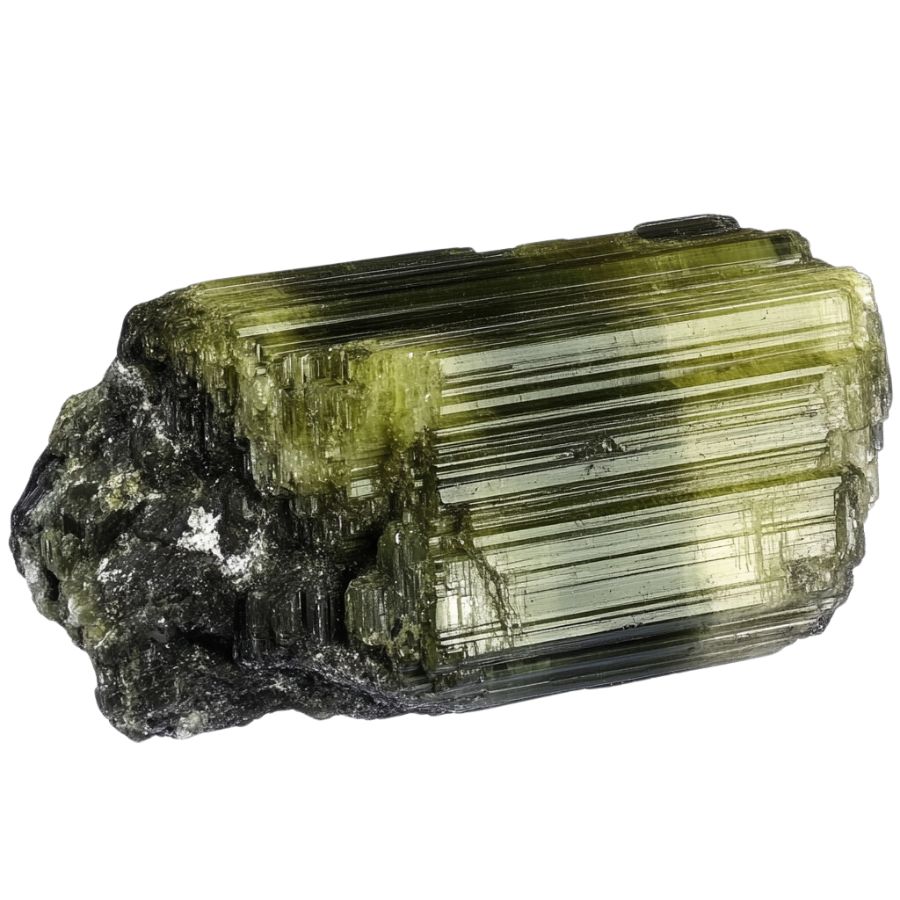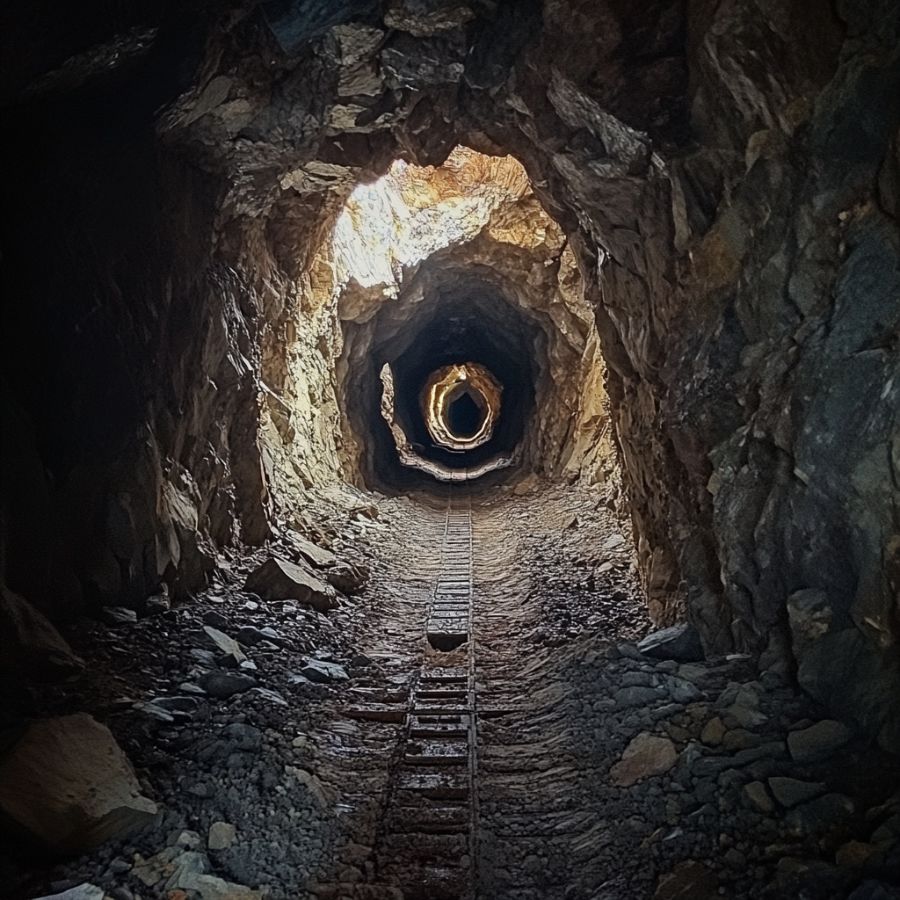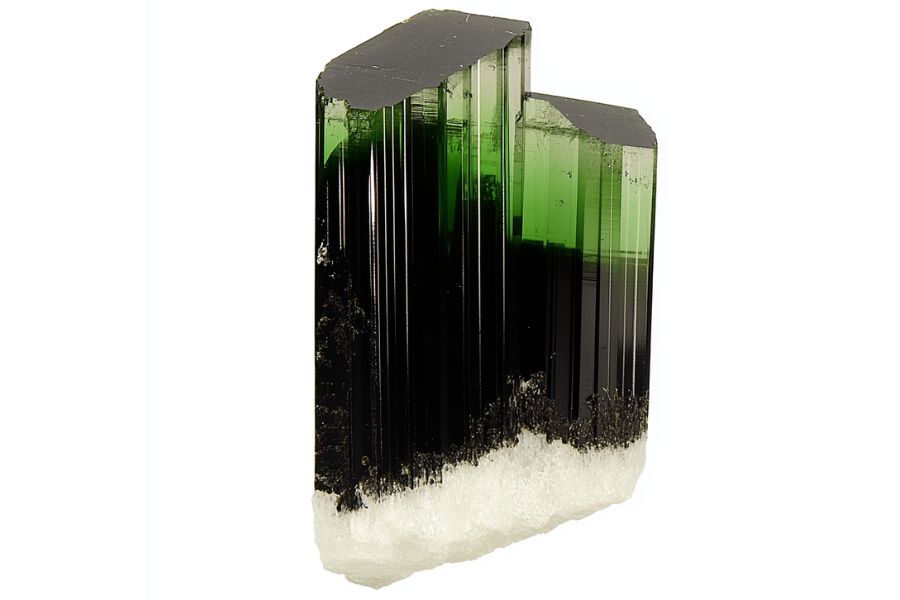Arkansas is home to the only public diamond mine in the world, but that’s not the only treasure hidden in its soil. Our State has been surprising rockhounds with its variety of gems for over a century.
While tourmaline isn’t as famous as Arkansas diamonds, these colorful crystals have been found scattered across several counties. Many locals have stumbled upon these gems while exploring the state’s mineral-rich areas.
We’ve done the hard work for you by tracking down the most promising spots to find tourmaline in Arkansas. Skip the wild goose chase and head straight to these tested locations.
Whether you’re new to rock hunting or a seasoned collector, these sites won’t disappoint.
How Tourmaline Forms Here

Tourmaline forms deep underground through intense heat and pressure. It originates from hot, mineral-rich fluids that move through fractures in rocks like granite and pegmatite. As these fluids cool, the minerals within them start to crystallize, forming tourmaline.
The color of tourmaline depends on the specific minerals involved, leading to a wide range of hues including pink, red, green, and blue.
Over millions of years, these crystals grow and become the beautiful, multifaceted stones we see today. Tourmaline is prized for its variety of colors and is often used in jewelry and decorative items.
The Types Of Tourmaline
Several incredible types of Tourmaline can be found in the US as well as in our state. Each is uniquely beautiful and interesting including:
Elbaite

Elbaite is found in pink, red, green, blue, yellow, and even colorless forms. What makes elbaite special is its ability to show multiple colors in a single crystal, like the famous “watermelon” tourmaline with pink and green hues.
This gem stands out due to its complex chemical makeup, which includes lithium, sodium, and aluminum. This composition gives Elbaite its diverse color range and dichroism, allowing it to display different colors when viewed from different angles.
Elbaite has a unique place in history as the first tourmaline variety in which lithium was discovered back in 1818. Some rare types, like the neon blue Paraiba elbaite, are highly sought after by collectors and jewelers.
Schorl

Schorl is known for its deep, rich color. It typically forms long, prismatic crystals with a shiny, glass-like surface when polished. Unlike other tourmalines, schorl gets its distinctive black color from high iron concentrations.
One of Schorl’s most fascinating features is its ability to become electrically charged through heating or rubbing. When charged, it can attract or repel small particles.
This unique electrical property makes Schorl valuable in various industries. It’s used in electronics and manufacturing to control static electricity and electromagnetic interference.
Despite being less colorful than other tourmalines, schorl’s practical applications make it an important and interesting variety.
Rubellite

Rubellite stands out with its vibrant pink to red colors. The most prized ones show a pure, saturated red without any brown or orange hints. This beautiful color comes from manganese in its makeup.
One cool thing about rubellite is its double refraction. It can look like it has two different colors when you view it from different angles.
Dravite

Dravite, or Brown Tourmaline, comes in shades from dark brown to light brown-yellow. It can look a bit like Smoky Quartz, with a semi-see-through quality.
Its crystals are often needle-like or prismatic, with points at both ends. This sets it apart from other tourmalines like the darker schorl or the colorful elbaite.
What makes dravite special is its rich sodium and magnesium content. This sets it apart from other tourmalines. It was first discovered in 1883 and named after the Drava River in Slovenia.
Indicolite

Indicolite is a rare and captivating blue to blue-green stone. It’s prized for its pure, bright blue color, which is considered the rarest within the tourmaline family. The hues can range from light blue-green to deep, rich blue, often with high clarity.
What sets Indicolite apart is its unique optical effects. It shows pleochroism, appearing to change color when viewed from different angles. Some specimens also display chatoyancy, creating a “cat’s eye” effect when cut in a certain way.
Indicolite is sometimes called “Brazilian sapphire” due to its resemblance to the precious gem. However, they’re different minerals.
The increasing demand for blue tourmalines has made indicolite highly sought-after in the gemstone market, appreciated for its beauty and rarity.
Watermelon Tourmaline

Watermelon tourmaline is truly one-of-a-kind. It looks just like a slice of watermelon, with a pink or red center and a green outer layer. This unique look happens because different elements join the crystal at different times as it grows.
These crystals often form in a rounded triangle shape. They’re see-through to somewhat clear and have a glass-like shine. When cut into slices, they really do look like little watermelons!
Cat’s Eye Tourmaline

Cat’s eye tourmaline is known for its mesmerizing chatoyancy effect. This creates a bright band across the stone’s surface, resembling a cat’s eye.
This stone comes in various colors, from green to pink to brown, and is usually semi-translucent to opaque.
What makes this stone special is the perfect alignment of tiny, needle-like inclusions inside it. These scatter light in a unique way, creating that eye-catching effect. It’s quite different from other tourmalines that don’t have this feature.
Unlike other cat’s eye stones, Tourmaline offers a wider range of colors and is often more affordable.
Achroite

Achroite is a rare, colorless variety of tourmaline that looks like a drop of clear water turned to stone. It’s completely transparent, making it unique among tourmalines which usually have color. The name comes from Greek, meaning “without color.”
What’s special about achroite is that it doesn’t change color when viewed from different angles. It means the stone can be cut in many ways without losing its clarity.
Verdelite

Verdelite is known for its beautiful green color. It can range from light green to deep emerald.
One thing that makes verdelite special is that you can find big, clear crystals of it. This isn’t always easy with other gemstones.
People love using verdelite in jewelry because its rich color and interesting light effects make it a popular choice for all kinds of accessories. Each piece of verdelite is like a little piece of nature you can wear.
Paraíba Tourmaline

Paraíba Tourmaline is a rare gemstone that catches the eye with its vibrant neon blue or green color. It’s like no other tourmaline you’ve seen before. The intense glow comes from copper in the stone, making it stand out from its cousins.
This stone is one of the rarest. For every 10,000 diamonds mined, only one Paraíba tourmaline is found.
It was only discovered in the late 1980s, making it a newcomer in the gem world. But Paraíba tourmaline’s unique color and rarity quickly made it a favorite among gem lovers.
Its discovery caused quite a stir in the gem community. Even small stones can be valuable because of how rare and beautiful they are.
What Rough Tourmaline Looks Like
When you’re out looking for rough Tourmaline on your own it’s important to know what you’re looking for. But before we dive into specifically what to look for you need to make sure you understand the type of rocks and minerals you’re seeing.
If you want REAL results finding incredible rocks and minerals you need one of these 👇👇👇
Finding the coolest rocks in isn’t luck, it's knowing what to look for. Thousands of your fellow rock hunters are already carrying Rock Chasing field guides. Maybe it's time you joined the community.
Lightweight, mud-proof, and packed with clear photos, it’s become the go-to tool for anyone interested discovering what’s hidden under our red dirt and what they've already found.
Join them, and make your next rockhounding trip actually pay off.
What makes it different:
- 📍 Find and identify 140 incredible crystals, rocks, gemstones, minerals, and geodes across the USA
- 🚙 Field-tested across America's rivers, ranchlands, mountains, and roadcuts
- 📘 Heavy duty laminated pages resist dust, sweat, and water
- 🧠 Zero fluff — just clear visuals and straight-to-the-point info
- ⭐ Rated 4.8★ by real collectors who actually use it in the field
Here are some tips to help you recognize rough tourmaline.
Look for Color Variations

Tourmaline comes in many colors, like pink, green, blue, and even black. Some pieces have multiple colors, like watermelon tourmaline, which is pink and green.
If you see these color mixes, it’s likely tourmaline. Keep an eye out for vibrant shades.
Assess the Density and Weight

Rough tourmaline is relatively heavy for its size. If you pick up a piece and it feels denser than expected, it could be tourmaline. This weight can help you confirm your find.
Examine the Crystal Structure

Tourmaline features distinctive crystal shapes, ranging from slender and elongated to chunky forms. Look for triangular cross-sections and striations on the surface, which indicate its unique growth patterns.
Check for Transparency

Some rough tourmaline can be slightly transparent. If you hold it up to the light, you might see through it a bit. This transparency can be a good sign that you have tourmaline.
A Quick Request About Collecting
Always Confirm Access and Collection Rules!
Before heading out to any of the locations on our list you need to confirm access requirements and collection rules for both public and private locations directly with the location. We haven’t personally verified every location and the access requirements and collection rules often change without notice.
Many of the locations we mention will not allow collecting but are still great places for those who love to find beautiful rocks and minerals in the wild without keeping them. We also can’t guarantee you will find anything in these locations since they are constantly changing.
Always get updated information directly from the source ahead of time to ensure responsible rockhounding. If you want even more current options it’s always a good idea to contact local rock and mineral clubs and groups
Tips on where to look
Once you get to the places we have listed below there are some things you should keep in mind when you’re searching:
Look for Sedimentary Rocks

Sedimentary rocks are great places to find tourmaline. These rocks form from layers of sand, mud, and minerals. Over time, minerals like tourmaline can get trapped.
Look in riverbeds or areas where sediment has built up. You might find small pieces or even larger crystals.
Explore Mines

Mines are great spots to find tourmaline. Many mines across the U.S. extract various gemstones, including tourmaline.
Some mines even allow visitors to search for gems themselves. Always check if they have guided tours or special digging days.
Search in Gravel Pits

Gravel pits are often overlooked, but they can be treasure troves. These pits dig deep into the earth, exposing layers of rock.
Tourmaline can be found in the gravel. Just sift through the material carefully.
Some Great Places To Start
Here are some of the better places to start looking for Tourmaline in Arkansas:
Always Confirm Access and Collection Rules!
Before heading out to any of the locations on our list you need to confirm access requirements and collection rules for both public and private locations directly with the location. We haven’t personally verified every location and the access requirements and collection rules often change without notice.
Many of the locations we mention will not allow collecting but are still great places for those who love to find beautiful rocks and minerals in the wild without keeping them. We also can’t guarantee you will find anything in these locations since they are constantly changing.
Always get updated information directly from the source ahead of time to ensure responsible rockhounding. If you want even more current options it’s always a good idea to contact local rock and mineral clubs and groups
Lake Catherine

Lake Catherine is a 1,940-acre lake in Garland County, Arkansas, close to Hot Springs. It’s part of the Ouachita Mountain region and was created in the 1920s when they built the Remmel Dam.
Tourmaline crystals have been found in the rocky areas near the shoreline, especially around the Polly Crews Cabin area.
The best spots to look are along the hiking trails that lead to the waterfall, where water has exposed different rock layers over time. The lake’s shore has lots of quartz, feldspar, and mica too.
The lake’s water level changes throughout the year, which often reveals new rocks and minerals along the shore. Spring and fall are the best times to search when the water levels are lower.
Clark area

Clark County sits in southwestern Arkansas, where the Ouachita Mountains meet the Coastal Plain. The region has a rich history of mineral discoveries, including quartz crystals and tourmaline.
The area’s geology comes from the Cretaceous period, which left behind different rock layers perfect for finding gemstones. Creek beds and river banks in Clark County are good spots to look for tourmaline.
Old quarries in the county are also promising spots because they expose deeper rock layers.
The best time to search is after rain when water washes away dirt and exposes new rocks. Local streams often reveal black tourmaline crystals mixed with quartz. The area around DeGray Lake is particularly known for its mineral deposits.
Dallas area

Dallas County is located in southern Arkansas, covering 668 square miles of rolling hills and scenic landscapes. The area includes small towns like Fordyce, Sparkman, and Carthage, and is part of the West Gulf Coastal Plain.
Tourmaline has been found in the county’s sedimentary rock formations. The best spots to look are along streams and riverbeds where water has worn away the top layers of rock.
Areas near Fordyce and Carthage have good spots where the old rock layers are exposed.
The region is also known for its diverse mineral deposits. While hunting for tourmaline, you might find other interesting stones like quartz, agate, and jasper. The mix of different rock types and natural erosion makes Dallas County an exciting place for gemstone searching.
Howard area

Howard County is in southwestern Arkansas, close to the Texas border. The county’s landscape features rolling hills and valleys created by ancient geological processes millions of years ago.
While quartz crystals are the most common find here, tourmaline specimens have been discovered in the rocky outcrops and mineral deposits throughout the county.
The best spots to look for tourmaline are around the various crystal mines in the area. Places like Wegner Quartz Crystal Mines and Twin Creek Crystal Mine have yielded good finds.
The stones are often found in the same areas as quartz crystals, especially in the weathered rock deposits and mineral veins that run through the mountains.
Grant area

Grant area is located in northwest Arkansas, featuring rolling hills, rocky mountaintops, and clear streams across its 630 square miles.
The county’s granite outcrops are prime spots for finding minerals. These outcrops formed millions of years ago and now serve as excellent hunting grounds for rockhounds.
The best places to look for tourmaline are near the granite formations and along stream beds. Local streams have naturally broken down larger rocks over time, making it easier to spot crystals.
Besides tourmaline, you might find quartz crystals, which Arkansas is famous for. The local geology also offers chances to find other interesting minerals like mica and feldspar.
Places Tourmaline has been found by county
After discussing our top picks, we wanted to discuss the other places on our list. Below is a list of the additional locations where we have succeeded, along with a breakdown of each place by county.
| County | Location |
| Pike | Crater of Diamonds State Park |
| Montgomery | Wegner Quartz Crystal Mines |
| Montgomery | Twin Creek Crystal Mine |
| Polk | Sweet Surrender Crystal Mine |
| Montgomery | Arrowhead Crystal Mine |
| Polk | Board Camp Crystal Mine |
| Montgomery | Fisher Mountain |
| Montgomery | Crystal Vista |
| Garland | Avant Mining |
| Montgomery | Bear Mountain Crystal Mine |
| Garland | Hamilton Hill Mine |
| Montgomery | McEarl Mine |
| Hot Spring | Magnet Cove |
| Garland | Lake Catherine State Park |
| Montgomery | Coleman’s Miller Mountain Mine |
| Montgomery | Blue Springs Recreation Area |
| Garland | Hot Springs National Park |
| Hempstead | Old Washington State Park |
| Baxter | Old Joe Slate Mine |
| Polk | Big Fork Creek |
| Montgomery | South Fork of the Ouachita River |
| Garland | West Mountain |
| Montgomery | Deer Creek |
| Garland | Salt Plains near Lake Ouachita |
| Pike | Prairie Creek |
| Montgomery | Mount Ida |
| Montgomery | Crystal Hill |
| Montgomery | Black Springs |
| Polk | Thunder Mountain |
| Pike | Lake Greeson |
| Montgomery | Chase Creek |
| Montgomery | Muddy Creek |
| Hot Spring | Jones Mill Quarry |
| Polk | Cove Creek |
| Polk | Hurricane Knob |
| Polk | Sulphur Springs |
| Montgomery | Old Spanish Diggings |
| Pike | Little Missouri River |
| Johnson | Spadra Creek |
| Polk | Rich Mountain |



